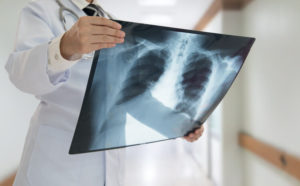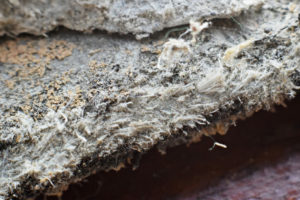Lung Disease
Chronic lung diseases prevent the lungs from working properly. Common lung diseases include lung cancer, asbestosis, COPD, silicosis, pulmonary fibrosis, and pulmonary hypertension. These conditions have a number of causes, including asbestos and silica exposure. Learn about the dangers of and treatment options for lung diseases and see if you are eligible for financial assistance from Lung Cancer Group.
What Is a Lung Disease?
 A lung disease is any condition affecting lung function. Many lung diseases are grouped into what doctors call interstitial lung disease.
A lung disease is any condition affecting lung function. Many lung diseases are grouped into what doctors call interstitial lung disease.
Interstitial lung disease is a group of more than 100 chronic lung conditions that limit the amount of oxygen the lungs can take in. Asbestosis, silicosis, and pulmonary fibrosis are all interstitial lung diseases, according to the Mayo Clinic.
Over 34 million Americans live with chronic lung conditions, according to the American Lung Association (ALA).
While some lung conditions are not life-threatening, others can greatly impact quality of life. Additionally, lung diseases caused by toxic substances like asbestos, a known carcinogen, and silica can be life-threatening.
Signs and symptoms of lung diseases vary depending on the exact condition.
- Chest pain
- Dry, persistent cough
- Shortness of breath
- Unintended weight loss
If you are suffering from a lung disease caused by exposure to asbestos or silica, Lung Cancer Group may be able to help you get compensation for treatment costs. Get started with a free case review today.
- Access Financial Aid and Justice
- Learn About Your Options
- Contact Us for Free

Types of Lung Diseases
There are three main types of lung disease: airway lung diseases, diseases that affect lung tissue, and lung diseases that affect circulation. Some lung diseases can be a combination of multiple types and affect airways, lung tissue, and circulation.
Airway Lung Diseases
These conditions affect the airways (tubes) that carry gasses, such as oxygen, in and out of the lungs. Airway lung diseases usually block or narrow the airways, making it difficult to breathe.
Examples of airway diseases include:
- Asthma causes airways to become inflamed and narrowed at times.
- Bronchiectasis occurs when the lungs’ airways widen due to damage. Mucus can accumulate and increase the risk of infection.
- Bronchiolitis is usually caused by a virus that builds up mucus in the airways. The build-up can lead to swelling and irritation in the bronchi (airways connecting the windpipe to the lungs) and make it difficult to breathe.
- Chronic obstructive pulmonary disease (COPD) is a long-term inflammatory lung disease that blocks airflow between the bronchi and the lungs. Chronic bronchitis and emphysema are considered types of COPD that affect different parts of the lungs.
Diseases That Affect Lung Tissue
These illnesses scar and inflame lung tissue, making the lungs incapable of expanding fully. Patients with lung tissue diseases have a hard time breathing deeply.
Examples of lung tissue disease include:
- Asbestosis causes irritation and thick tissue to build up around the lungs, making it difficult to breathe.
- Emphysema weakens the lung tissue, causing the walls of the alveoli (air sacs) to break down and block airflow.
- Lung cancer weakens lung tissue as cancerous cells grow out of control and develop tumors.
- Pulmonary fibrosis builds up scar tissue in the lungs, making it difficult to breathe.
- Sarcoidosis causes tiny collections of inflammatory cells (granulomas) to grow in several parts of the body such as the lungs or the heart.
- Silicosis is a potentially deadly type of pulmonary fibrosis caused by breathing in tiny bits of silica dust. Making stone countertops using natural stone or quartz surfacing could release this dust into the air and put workers at risk.
Did you develop a lung disease from exposure to asbestos or silica? Contact us today to see how we can help you get the financial assistance you need to cover medical expenses.
Lung Diseases That Affect Circulation
Lung diseases can affect circulation by making it difficult for blood vessels to maneuver through the lungs. These diseases are often caused by inflammation, clotting, or scarring of the blood vessels.
Diseases that impact circulation make it harder for the lungs to take in oxygen and release carbon dioxide. Some lung circulation illnesses may also affect heart function.
An example of a lung circulation disease is pulmonary hypertension, a type of high blood pressure that affects the right side of the heart and the arteries in the lung. Additionally, sarcoidosis, which can develop in the lungs and the heart, may also cause cardiac arrhythmias (irregular heartbeats).
Possible Causes of Lung Disease


Examples of risk factors for lung disease include:
- Allergens
- Environmental pollutants
- Certain genetic mutations
- Occupational exposure to asbestos or silica dust
- Smoking tobacco, including secondhand smoke
Asbestos Exposure
When inhaled, tiny, sharp asbestos fibers can become lodged in lung tissue, causing inflammation and scarring over time.
The body has difficulty expelling these fibers, and after 10-50 years of damage, asbestos can cause serious lung diseases to form.
Asbestos-related lung diseases include:
- Asbestosis (chronic lung scarring)
- Lung cancer
- Mesothelioma (cancer that forms in the lining of the lungs or other organs)
Sadly, symptoms of asbestos-related lung cancer and mesothelioma often don’t develop until they are in later stages.
Get financial help for asbestos-related lung diseases. Start the process now with a free case review.
- Access Financial Aid and Justice
- Learn About Your Options
- Contact Us for Free




Silica Dust Exposure
Exposure to silica dust, primarily from quartz in stone countertops, can lead to silicosis.
When inhaled, silica dust particles become embedded deep in the lungs, causing inflammation and the formation of scar tissue (fibrosis).
Over time, this scarring reduces lung function, making breathing difficult. Chronic exposure to silica dust can also increase the risk of lung cancer and other respiratory diseases.
The body’s inability to effectively clear these inhaled particles means that the damage accumulates, with symptoms often emerging decades after the initial exposure.
Diagnosing Lung Diseases
Doctors use various tests to diagnose lung diseases. These tests show whether your symptoms are caused by lung disease or another condition, such as heart failure.
Common diagnostic tests include:
- Arterial blood gas analysis measures how well your lungs remove carbon dioxide and bring oxygen to your blood.
- Biopsies are small sample tissues taken from parts of your body that may be affected by lung disease. They are the only way to confirm if you have lung cancer.
- Chest X-rays produce images of your lungs, heart, airways, blood vessels, and bones of your spine and chest.
- Computerized tomography (CT) scans combine X-ray images taken from different angles and use computers to create cross-sectional images of the blood vessels, bones, and soft tissues inside your body.
- Pulmonary function tests measure the amount of air you can breathe in and out and whether your lungs deliver sufficient oxygen to your blood. The most common test is spirometry, which requires you to blow into a tube connected to a machine that measures lung function.
Treatment Options for Lung Disease


Treatment for Airway Lung Disease
Each person’s lung disease treatments are different and depend on their overall health, age, and symptoms.
Common treatment options include:
- Medications can treat some lung diseases, such as COPD.
- Noninvasive ventilation (NIV) can help people who experience higher levels of carbon dioxide in the blood. NIV helps with the breathing process to decrease mortality and prevent hospitalization.
- Pulmonary rehabilitation programs are classes held at outpatient clinics, hospitals, or online. They combine disease management education, exercise training, nutrition education, social support, and counseling.
- Surgery can help people with severe lung disease. For example, doctors may recommend lung volume reduction surgery, bullectomy, and a lung transplant for people with severe COPD.
- Clinical trials are research studies that test the safety and efficacy of new medical treatments. They may be able to help people with severe lung disease.
Talk to your health care provider to learn more about which treatments will work best in your case. The right lung disease treatment plan can greatly increase your quality of life and survival.
Treatment for Lung Tissue Disease
As with treatments for airway lung diseases, treatments for lung tissue diseases vary from case to case.
Common treatments for lung tissue diseases include:
- Medications such as corticosteroids to help ease lung inflammation and irritation in patients with lung sarcoidosis.
- Organ transplant may help if sarcoidosis or asbestosis have severely damaged your lungs.
- Physical therapy can reduce side effects such as fatigue and decreased muscle strength.
- Pulmonary rehabilitation can reduce respiratory symptoms.
- Clinical trials may allow people with lung tissue diseases to access new treatment options.
Treatment for Lung Circulation Disease
Treatments for lung circulation diseases vary depending on the condition, the patient’s health, and other factors.
Common treatments include:
- Blood thinners such as warfarin.
- High-dose calcium channel blockers such as amlodipine, nifedipine, and diltiazem, which can lower blood pressure.
- Medications to relax blood vessels, such as epoprostenol and selexipag, or increase blood flow, such as tadalafil and sildenafil.
- Oxygen therapy can treat pulmonary hypertension symptoms.
- Surgeries such as lung and heart-lung transplants and atrial septostomy. An atrial septostomy creates an opening between the right and upper left chambers of the heart to reduce pressure on the right side of the heart.
Get a free case review to find help affording lung disease treatments. You may qualify for financial aid that can cover medical expenses.
- Access Financial Aid and Justice
- Learn About Your Options
- Contact Us for Free




Lung Disease Prognosis
The prognosis or expected outcome of lung diseases varies depending on the type of condition.
Talk to your medical provider to learn more about your prognosis.
Survival Rates for Lung Disease Patients
Survival rates are an estimation to help people know what to expect with their condition. For example, a 5-year survival rate of 50% means that half of patients will survive beyond 5 years.
Here are some survival rates for common lung diseases:
- COPD has a varying survival rate that depends on several factors, including how serious a patient’s case is. It’s estimated that the 5-year survival rate ranges between 40-70%.
- Lung cancer has an average 5-year survival rate of 18.6%.
- Pulmonary fibrosis has a 5-year survival rate of about 45%.
- Silicosis has a 3-year survival rate of 68.3%.
Your medical provider can tell you more about your lung disease’s survival rate.
Financial Support Options for Lung Disease
Treating lung diseases can be expensive, especially if they aren’t covered by insurance. Fortunately, it may be possible to access financial compensation to cover treatment costs.
Financial options for those with lung diseases include:
- Asbestos trust fund claims were created by bankrupt asbestos companies to compensate those with asbestos-related illnesses. If you developed a lung disease due to asbestos exposure, you may be eligible to file an asbestos trust fund claim.
- Personal injury lawsuits compensate people who developed lung diseases due to exposure to asbestos and other toxins. If your lawsuit is successful, you may recover financial aid for medical fees, pain and suffering, and lost wages.
- Wrongful death lawsuits compensate the families of people who died due to lung diseases, allowing them to afford funeral costs, lingering medical bills, and any other expenses.
Lung Cancer Group may be able to help you access these financial support options. We are dedicated to connecting families with compassionate legal help as they navigate lung illnesses caused by asbestos or silica dust.
Learn how we can help you with a free case review today.
Lung Disease FAQs
What are the most common lung diseases?
The most common lung diseases are chronic obstructive pulmonary disease (COPD) and asthma. Both affect lung airways and can be caused by allergies, pollution, and toxic fibers like asbestos and silica.
Does asbestos exposure cause lung disease?
Yes, asbestos exposure can cause or worsen lung diseases. When asbestos fibers are inhaled, they can become lodged in the lungs, leading to inflammation and scarring.
Asbestos-related lung diseases include:
- Asbestosis
- Lung cancer
- Mesothelioma
- Pleural diseases (which affect the lining of the lungs)
The risk of developing asbestos-related lung diseases increases with the amount and duration of exposure.
If you believe asbestos exposure caused you to develop a chronic lung condition, contact us to see how we can help.
What causes lung disease?
Any of the following can cause lung diseases:
- Allergens
- Cigarette smoke
- Occupational asbestos or silica exposure
- Pollution
Additionally, the causes of some lung conditions remain unknown.
What lung diseases are terminal or fatal?
Many lung diseases can be fatal without the right treatment — even asthma. However, some of the most deadly lung diseases include lung cancer, asbestosis, silicosis, and COPD.
Make sure that you’re getting prompt and expert medical care if you’ve been diagnosed with any of these lung diseases.
How many people have a lung disease?
Sadly, lung diseases are fairly common. The ALA estimates that 34 million Americans live with lung conditions.
Globally, a systematic analysis from the Global Burden of Disease Study 2017 estimates 545 million people suffer from a chronic respiratory condition or lung disease.

